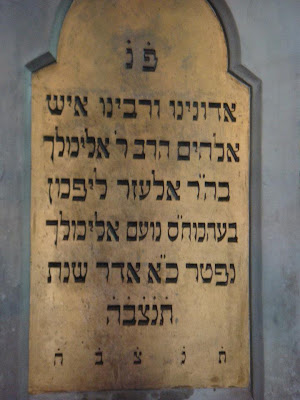Musings from Students of the Pardes Institute of Jewish Studies in Jerusalem
Posted on March 29, 2012 by Lauren Schuchart
(The fourth in a series of 5 posts detailing my heritage trip to Poland… originally posted on my blog)
___________________
Belzec
When many people think of concentration camps, they think of Auschwitz. Why? Because many of the survivors of the Holocaust were liberated from there. When we hear horrific stories, they are mostly stories of Auschwitz.
But there are a few camps that aren’t as well-known, because there were no survivors. The sole purpose of these camps was extermination; there were no prisoners, no laborers, no hope. Every person that entered through its gates were killed almost immediately.
Belzec is such a camp, where approximately 500,000 Jews were murdered.
| Sign outside of Belzec |
| Part of the Belzec memorial |
| Entrance to the Belzec memorial |
| In the museum at Belzec |
| In the museum at Belzec |
| Train tracks at Belzec. |
___________________
“If you think good, It will be good.”
We had the great honor and opportunity to visit the small town of Lezajsk.
Lezajsk was one of the largest centers of the Chasidic movement in Poland. Chasidism is a movement within Judaism that emphasizes the “inner dimensions” of the Torah, or Jewish mysticism. Followers of this movement consider loving-kindness, spirituality, and joy as fundamental components of the Jewish faith. This movement is incredibly deep and rich, and I am certainly not doing it justice with this basic explanation.
We visited the grave of Elimelech of Lezajsk, an important, foundational figure in the Chasidic movement. He wandered for many years, spreading the word of Chasidism, until he finally settled in Lezajsk in 1772. Next to his grave, we talked about his role in Chasidism, learned a few of his teachings, and told stories of his life.
 |
| Photo by Daniel ShibleyGrave of the Chassidic master, Rabbi Elimelech of Lezajsk |
After visiting the grave, we went to the nearby beit midrash (house of learning) and, in Chasidic tradition, did a couple of “L’chaims!” (toasts to life!).
Levi asked us to think about why the Chasids were frequently celebrating and making “l’chaims,” even in seemingly dark times. He said that our physicality can lead us down to the depths, which is the opposite of what the Chassidic movement teaches us. By easing our physicality, we can make room for spirituality. And the way to spirituality is not through melancholy and despair, but through joy and positive thinking (and sometimes, a little bit of whiskey).
In the words of the Chassids, “If you think good, it will be good.” L’chaim, to life!
| Levi makes a l’chaim. |
| L’chaim! |
| Andrew gives a L’chaim to the group |
___________________
Krakow
| Kosher restaurant in Krakow |
| Kosher restaurant in Krakow |
| Krakow |
| Krakow |
| The entrance to the Remah’s synagogue (Rabbi Mosses Isserles of the 16th century). |
| Inside the Remah Shul. |
| Tempel Synagogue |
| Tempel Synagogue |
| Tempel Synagogue |
| Krakow Jewish Community Center |
| A cemetary in Krakow. |
|
I couldn’t help but to post this picture of Kyle, Levi, and Leah, posing in their hermonits.
|
| Building a Jewish future in Krakow. |
Pardes trips to Poland are run in partnership with Heritage Seminars. The Claims Conference has provided trip scholarships for qualifying Pardes participants, as well as subsidies for program components directed at Jewish educators.
